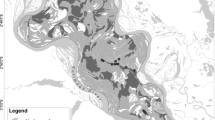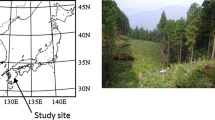Abstract
Emergence and establishment of Tsuga sieboldii seedlings were monitored for six years in an old-growth mixed forest in Japan, to clarify the reason why adult T. sieboldii trees are distributed only on convex slopes. T. sieboldii seedlings germinated on exposed soils without broad-leaved litter cover on both convex and concave slopes, but they died out from concave slope during the first two years after germination. Along a gradient from convex to concave slope, litter cover became higher and surface soil erosion became severer, and T. sieboldii seedlings died at the plots with severe surface soil erosion. Other environmental variables, such as relative illuminance, vegetation cover of seedling layer and soil water potential were not significantly different between convex and concave slopes. We concluded that the restricted seedling establishment of T. sieboldii to convex slope is determined by stability of surface soils and broad-leaved litter cover.
Similar content being viewed by others
References
Antos, J. A. & Zobel, D. B. 1984. Habitat relationships of Chamaecyparis nootkatensis in southern Washington, Oregon, and California. Can. J. Bot. 64: 1898–1909.
Bartlett, R. M., Reader, R. J. & Larson, D. W. 1991. multiple controls of cliff-edge distribution patterns of Thuja occidentalis and Acer saccharum at the stage of seedling recruitment. J. Ecol. 79: 183–197.
Bond, W. J. 1989. The tortoise and the hare: ecology of angiosperm dominance and gymnosperm persistence. Biol. J. Linnean Soc. 36: 227–249.
Chichibu Geologic Research Group. 1966. Geology in the vicinity of the Tokyo University Forest at Chichibu. Miscellaneous Information, the Tokyo University Forest 16: 73–85 (in Japanese with English summary).
Gregory C. C. & Petty J. A. 1973. Valve actions of bordered pits in conifers. J. Exp. Bot. 24: 763–767.
Harmon, M. E., Bratton, S. P. & White, P. S. 1983. Disturbance and vegetation response in relation to environmental gradients in the Great Smoky Mountains. Vegetatio 55: 129–139.
Hashidume, H. & Yamamoto, S. 1975. Studies on the process of formation of beech forests II: Differences in characteristics of seedlings in different growth conditions. Transaction of 86th Meeting of Japanese Forestry Society: 228–229 (in Japanese).
Hirabuki, Y. 1990. Description of community structure and ecological characteristics of component woody species in a temperate mixed forest, Northeast Japan. Bulletin of Miyagi University of Education (Part II, Natural Science and Education) 25: 23–43 (in Japanese with English summary).
Hunter, J. C. & Parker, V. T. 1993. The disturbance regime of an old-growth forest in coastal California. J. Veg. Sci. 4: 19–24.
Kawaguchi, T. & Takiguchi, K. 1957. Studies of soil erosion on mountain areas. (3) Experiments on erosion control function of ground cover. Bull. Gov. Forest Exp. Station 95: 91–119 (in Japanese with English summary).
Kira, T. 1948. On the altitudinal arrangement of climatic zones in Japan. A contribution to the rational land utilization in cool highlands. Kanchi-Nogaku 2: 143–173 (in Japanese).
Li Xiwen & Walker, D. 1986. The plant geography of Yunnan Province, southwest China. J. Biog. 13: 367–397.
Maeda, T. & Yoshioka, J. 1952. Studies on the vegetation of Chichibu mountain forest. (2) The plant communities of the temperate mountain zones. Bull. Tokyo Univ. Forest 42: 129–150 +3 pls (in Japanese with English summary).
Nakamura, F. 1990. Perspectives for the effects of geomorphic processes. Biol. Sci. 42: 57–67 (in Japanese).
Nakamura T. 1992. Effect of bryophytes on survival of conifer seedlings in subalpine forests of central Japan. Ecol. Res. 7: 155–162.
Nakamura, T. & Obata, K. 1985. Differences in ecological character between Abies veitchii and Tsuga diversifolia II. Distribution of seedlings on the moss-covered floor of Tsuga forest on Mt. Fuji. Bull. the Tokyo Univ. Forest 74: 67–79 (in Japanese with English summary).
Nakashizuka, T. 1991. Population dynamics of coniferous and broad-leaved trees in a Japanese temperate mixed forest. J. Veg. Sci. 2: 416–418.
Nakashizuka, T. & Yamamoto, S. 1987.Natural disturbance and stability of forest community. Jap. J. Ecol. 37:19–30 (in Japanese with English summary).
Ohsawa, M. 1987. Habitat differentiation and the ecological niche in vegetation. Physiological Ecology, Japan 24 (Special No.): 15–27.
Ohsawa, M. & Ozaki, K. 1992. Hierarchical analysis of vegetation/ environment pattern for east Asian extra-tropical evergreen broad-leaved forests. Jap. J. Biometeorol. 29 (Suppl.): 93–103.
Ohwi, J. & Kitagawa, M. 1983. New flora of Japan. Shibundo, Tokyo (in Japanese).
Ozaki, K. & Ohsawa, M. 1995. Successional change of forest pattern along topographical gradients in warm-temperate mized forests in Mt. Kiyosumi, central Japan. Ecol. Res. 10: 223–234.
Running S. W., Waring R. H. & Rydell R. A. 1975. Physiological control of water flux in conifers: a computer simulation model. Oecologia 18: 1–16.
Saito, K. & Tachibana, H. 1971. Relations between the seedlings and the habitat conditions in the Abies firma forest in the Sendai area, northeast Japan. Annu. Rep. JIBP-CT(P) 1970: 157–160.
Sakai, A. & Ohsawa, M. 1993. Vegetation pattern and microtopography on a landslide scar of Mt. Kiyosumi, central Japan. Ecol. Res. 8: 47–56.
Swanson, F. J., Kratz, T. K., Caine, N. & Woodmansee, R. G. 1988. Landform effects on ecosystem patterns and processes. BioScience 38: 92–98.
Takahashi, I. 1979. Studies on mycoflora and diseases of coniferous trees at the central Hokkaido, Japan: Special reference to Ascomycetes, Fungi imperfecti and Uredinales. Bull. Tokyo Univ. Forest 69: 1–143 (in Japanese with English summary).
Takahashi, Y., Sato, S., Shibata, S., Takahashi, I. & Hatano, K. 1981. Studies on natural regeneration of Picea jezoensis and Abies sachalinensis. Transactions of the Meeting in Hokkaido Branch of the Japanese Forestry Society 30: 85–87 (in Japanese).
Takeda, Y. 1992. Landslide. Chapter 5. Topography and geology as primary causes. Pp. 133–161. In: Japan Society of Erosion Control Engineering (ed.), Phenomenon of soil movement on slopes. Sankai-do, Tokyo (in Japanese).
Tanaka, N. 1985. Patchy structure of a temperate mixed forest and topography in the Chichibu Mountains, Japan. Jap. J. Ecol. 35: 153–167.
Tsukamoto, Y. & Ohta, T. 1988. Runoff process on a steep forested slope. J. Hydrol. 102: 165–178.
Veblen, T. T. & Ashton, D. H. 1978. Catastrophic influences on the vegetation of the Valdivian Andes, Chile. Vegetatio 36: 149–167.
Woodward, F. I. 1987. An introduction to phytoclimatology. Cambridge University Press, Cambridge.
Yamamoto, S. 1993. Seedling establishment of Chamaecyparis obtusa in different microenvironments in the Akasawa Forest Reserve, central Japan. Jap. J. Forestry Soc. 75: 519–527.
Yamamoto, S. 1994. Seedling establishment of Chamaecyparis pisifera on different substrata in an old-growth C. pisifera stand, Akasawa Forest Reserve, central Japan. Jap. J. Forestry Soc. 76: 178–181.
Yamanaka, T. 1979. Forest vegetation in Japan. Tsukiji-Shokan, Tokyo (in Japanese).
Yoshida, N. & Ohsawa, M. 1996. Differentiation and maintenance of topo-community patterns with reference to regeneration dynamics in mixed cool-temperate forests in the Chichibu Mountains, central Japan. Ecol. Res. 11: 351–362.
Zobel, D. B. & Antos, J. A. 1991. Growth and development of natural seedlings of Abies and Tsuga in old-growth forest. J. Ecol. 79:985–998.
Author information
Authors and Affiliations
Rights and permissions
About this article
Cite this article
Yoshida, N., Ohsawa, M. Seedling success of Tsuga sieboldii along a microtopographic gradient in a mixed cool-temperate forest in Japan. Plant Ecology 140, 89–98 (1999). https://doi.org/10.1023/A:1009740016420
Issue Date:
DOI: https://doi.org/10.1023/A:1009740016420




